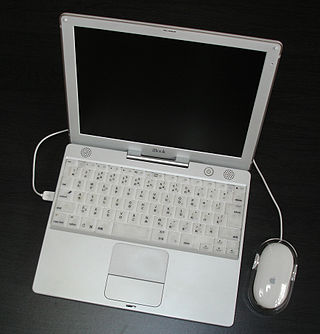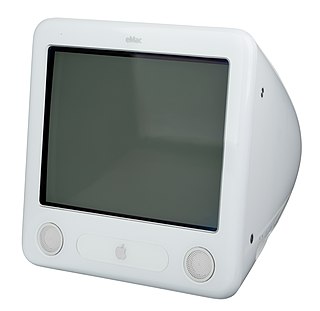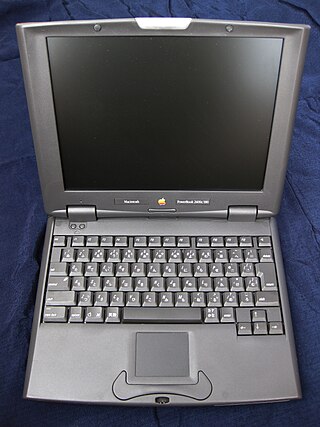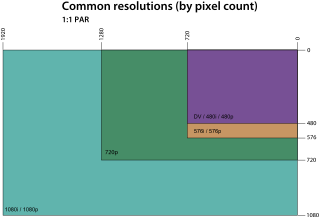
iBook is a line of laptop computers designed, manufactured, and sold by Apple Computer from 1999 to 2006. The line targeted entry-level, consumer and education markets, with lower specifications and prices than the PowerBook, Apple's higher-end line of laptop computers. It was the first mass consumer product to offer Wi-Fi network connectivity, which was then branded by Apple as AirPort.

The Power Macintosh G3 is a series of personal computers designed, manufactured, and sold by Apple Computer from November 1997 to August 1999. It represented Apple's first step towards eliminating redundancy and complexity in the product line by replacing eight Power Macintosh models with three: Desktop and Mini Tower models for professional and home use, and an All-In-One model for education. The introduction of the Desktop and Mini Tower models coincided with Apple starting to sell build-to-order Macs directly from its web site in an online store, which was unusual for the time as Dell was the only major computer manufacturer doing this. Apple's move to build-to-order sales of the Power Macintosh G3 also coincided with the acquisition of Power Computing Corporation, which had been providing telephone sales of Macintosh clones for more than two years.

The eMac is a discontinued all-in-one Mac desktop computer that was produced and designed by Apple Computer. Released in 2002, it was originally aimed at the education market but was later made available as a cheaper mass-market alternative to Apple's "Sunflower" iMac G4. The eMac was pulled from retail on October 12, 2005, and was again sold exclusively to educational institutions thereafter. It was discontinued by Apple on July 5, 2006, and replaced by a cheaper, low-end iMac G5 that, like the eMac, was exclusively sold to educational institutions.
Apple Inc. has sold a variety of LCD and CRT computer displays. Apple paused production of their own standalone displays in 2016 and partnered with LG to design displays for Macs. In June 2019, the Pro Display XDR was introduced, however it was expensive and targeted for professionals. Nearly three years later, in March 2022, the Studio Display was launched as a consumer-targeted counterpart to the professional monitor. These two are currently the only Apple-branded displays available.

The Twentieth Anniversary Macintosh is a limited-edition personal computer released in 1997 to mark Apple's 20th birthday. The machine was a technological showcase of the day, boasting a number of features beyond simple computing, and with a price tag aimed at the "executive" market.

The Apple Display Connector (ADC) is a display and data connector developed by Apple, Inc. as a proprietary modification of the DVI connector. ADC combines analog and digital video signals, USB, and power all in one cable. It was used in later versions of the Apple Studio Display, including the final 17" CRT model, and most versions of the widescreen Apple Cinema Display, after which Apple adopted standard DVI connectors on later models.

The PowerBook G4 is a series of notebook computers manufactured, marketed, and sold by Apple Computer between 2001 and 2006 as part of its PowerBook line of notebooks. The PowerBook G4 runs on the RISC-based PowerPC G4 processor, designed by the AIM (Apple/IBM/Motorola) development alliance and initially produced by Motorola. It was built later by Freescale, after Motorola spun off its semiconductor business under that name in 2004. The PowerBook G4 has had two different designs: one with a titanium body with a translucent black keyboard and a 15-inch screen; and another in an aluminum body with an aluminum-colored keyboard, in 12-inch, 15-inch, and 17-inch sizes.

The Power Mac G4 is a series of personal computers designed, manufactured, and sold by Apple Computer from 1999 to 2004 as part of the Power Macintosh line. Built around the PowerPC G4 series of microprocessors, the Power Mac G4 was marketed by Apple as the first "personal supercomputers", reaching speeds of 4 to 20 gigaFLOPS. This was the first existing Macintosh product to be officially shortened as "Mac", and is the last Mac able to boot into classic Mac OS.

The PowerBook G3 is a series of laptop Macintosh personal computers designed, manufactured, and sold by Apple Computer from 1997 to 2001. It was the first laptop to use the PowerPC G3 (PPC740/750) series of microprocessors, and was marketed as the fastest laptop in the world for its entire production run. The PowerBook G3 was succeeded by the PowerBook G4.

The Apple Cinema Display is a line of flat-panel computer monitors developed and sold by Apple Inc. between 1999 and 2011. It was initially sold alongside the older line of Studio Displays, but eventually replaced them. Apple offered 20, 22, 23, 24, 27, and 30-inch sizes, with the last model being a 27-inch size with LED backlighting.

The iMac G4 is an all-in-one personal computer designed, manufactured, and sold by Apple Computer from January 2002 to August 2004. It was announced at Macworld San Francisco in January of 2002. It replaced the iMac G3 and was succeeded by the iMac G5.

The iMac G3, originally released as the iMac, is a series of Macintosh personal computers Apple Computer sold from 1998 to 2003. The iMac was Apple's first major product release under its CEO Steve Jobs, who had recently returned to the financially troubled company he co-founded after eleven years away. Jobs reorganized the company and simplified the product line. The iMac was designed as Apple's new consumer desktop product—an inexpensive, consumer-oriented computer that would easily connect to the Internet.

The MacBook is a line of Mac laptops sold by Apple Inc. between May 2006 and February 2012. It replaced the iBook series of notebooks as a part of Apple's transition from PowerPC to Intel processors. Positioned as the low end of the MacBook family, below the premium ultra-portable MacBook Air and the performance-oriented MacBook Pro, the MacBook was aimed at the consumer and education markets. It became the best-selling Mac in Apple's history. For five months in 2008, it was the best-selling laptop of any brand in US retail stores.

The Mini-DVI connector is used on certain Apple computers as a digital alternative to the Mini-VGA connector. Its size is between the full-sized DVI and the tiny Micro-DVI. It is found on the 12-inch PowerBook G4, the Intel-based iMac, the MacBook Intel-based laptop, the Intel-based Xserve, the 2009 Mac mini, and some late model eMacs.

The PowerBook 2400c is a subnotebook in Apple Computer's PowerBook range of Macintosh computers, weighing 4.4 pounds (2.0 kg). Manufacturing was contracted to IBM Japan. In a return to the PowerBook 100 form factor, it was introduced in May 1997 as a late replacement for the PowerBook Duo 2300c, which had been the last of the subnotebook PowerBook Duo series. The 2400c was discontinued in March 1998, with no immediate replacement — the model that followed it was the much larger PowerBook G3 Series. However, in Japan a 2400c with a 240 MHz CPU was offered shortly after the original model's discontinuation, until the end of the year.

The Power Macintosh 5500 is a personal computer designed, manufactured, and sold by Apple Computer from February 1997 to March 1998. Like the Power Macintosh 5260 and 5400 that preceded it, the 5500 is an all-in-one design, built around a PowerPC 603ev processor operating at 225, 250 or 275 megahertz (MHz).

The Dreamcast VGA Box is an accessory for Sega's Dreamcast video game console that allows it to connect to a video display such as a computer monitor or an HDTV set through a VGA port. Because the Dreamcast hardware can produce a VGA-compatible video signal natively, this connection provides improved picture quality compared to standard composite video or S-Video connections, along with support for progressive scan video.

The graphics display resolution is the width and height dimension of an electronic visual display device, measured in pixels. This information is used for electronic devices such as a computer monitor. Certain combinations of width and height are standardized and typically given a name and an initialism which is descriptive of its dimensions. A graphics display resolution can be used in tandem with the size of the graphics display to calculate pixel density. An increase in the pixel density often correlates with a decrease in the size of individual pixels on a display.
Apple Inc. has produced and sold numerous music and multimedia speakers, available for standalone purchase and bundled with Macintosh products.

















